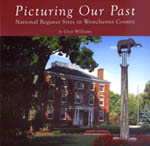America's First Parkway
Westchester's First Park
The Bronx River Parkway Reservation was primarily conceived as a pollution-control project to relieve the severe contamination of the Bronx River in the late nineteenth century.
Like most urban streams of the era, the Bronx River served as an open sewer and public dumping ground. According to parkway promoters, numerous factories, housing developments, small farms, and businesses located between the Bronx and White Plains were using the river as "promiscuous dumping grounds for refuse of all kinds."
Periodic flooding compounded the problems, especially during spring freshets. After floodwaters receded, low-lying areas along the river were covered with sewage and mosquito-breeding pools that threatened public health.
In 1896 The Bronx Valley Sewer commission reported that a road through the Bronx Valley could be built over a sewer. There was already a dirt track known as the "pipeline road" through most of the distance of the valley.
A more substantial highway could be built at minimal cost within the sewer reservation and could be constructed as community needs demanded. "This highway, and the reservation with the river flowing through it," the study advised, could become "a beautiful and picturesque feature of the section at a very small expense . . . since it is naturally very picturesque."
Though the details of pipeline location may vary, this early vision was substantially implemented over the next 30 years.
Cleanup and Forestry
In addition to reclaiming the Bronx River, the Bronx Parkway Commission, as it was called, cleaned each parcel of land as soon as it acquired title. The BPC immediately instituted a forestry program. "The condition of the trees in this section of the country," the BPC noted, was "cause for grave concern." Prompt measures were necessary.
It hired a forester, Albert N. Robson, who was noted for his experience in tree care. In addition, the commission engaged Hermann Merkel, a landscape architect and forester at the Bronx Zoo and Botanical Gardens, who was considered to be a recognized authority on various tree pests. Robson’s and Merkel’s first year with the commission resulted in 13,018 dead trees being removed, 5,037 trees trimmed, and 16,039 trees improved and reclaimed by surgery.
Success
The Bronx River Parkway Reservation was a success long before the parkway was completed. The project strongly influenced public sentiment in favor of supporting additional parkways, recreational facilities, and improved transportation routes.
Even before the entire road was open, 17,700 vehicles were counted at 233rd Street in the Bronx during a thirteen-hour period in 1924. By the summer of 1927, as many as 35,000 cars traveled the drive on sunny weekends and holidays.
As the world’s first public parkway designed to accommodate modern motorcars, the Bronx River Parkway attracted national – and even international – attention. Numerous civic leaders, chambers of commerce, and city officials from around the world contacted the WCPC for information about building parks and parkways. Officials in Nanking, China, announced their interest in building a parkway patterned after the BRPR and requested information from the WCPC. Thomas MacDonald, chief of the U. S. Bureau of Public Roads, visited Downer to learn more about Westchester County’s parkways, which were to be used as a model for the design, landscape treatment, and development of a new parkway along the Potomac in Washington, D.C. Knoxville, Tennessee officials also announced they wanted to build a similar parkway to the new Great Smokey Mountains National Park. Visitors from England, Canada, Japan, and the United States toured Westchester County parkways to learn about the Westchester experience. Landscape architects John Wosky and Kenneth McCarter of Yosemite and Yellowstone National Parks spent two months working in the WCPC offices, observing its landscape designers and construction work.
Source
This page is excerpted heavily from The Historic American Engineering Record (HAER) documentation of the Bronx River Parkway Reservation. To see that detailed documentation, click the button below.
Photos: Westchester County Historical Society
For additional larger photos, of both before and after the Reservation was constructed, click the Photos link in the main banner above.








